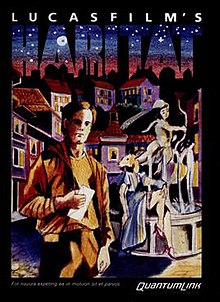| Habitat | |
|---|---|
 | |
| Developer(s) | Lucasfilm Games Quantum Link Fujitsu |
| Publisher(s) | Quantum Link Fujitsu |
| Director(s) | Chip Morningstar[3] |
| Producer(s) | Steve Arnold[3] |
| Designer(s) | Chip Morningstar[3] Randy Farmer |
| Programmer(s) | Chip Morningstar[3] Randy Farmer[3] Aric Wilmunder[3] Janet Hunter[3] |
| Artist(s) | Gary Winnick[3] |
| Platform(s) | Commodore 64, FM Towns, Microsoft Windows, Mac OS |
| Release |
|
| Genre(s) | Massively multiplayer online role-playing game |
| Mode(s) | Multiplayer |
Habitat is a massively multiplayer online role-playing game (MMORPG) developed by LucasArts. It is the first attempt at a large-scale commercial virtual community[4][5] that was graphic based. Initially created in 1985 by Randy Farmer, Chip Morningstar,[6] Aric Wilmunder and Janet Hunter, the game was made available as a beta test in 1986 by Quantum Link, an online service for the Commodore 64 computer and the corporate progenitor to AOL. Both Farmer and Morningstar were given a First Penguin Award at the 2001 Game Developers Choice Awards for their innovative work on Habitat. As a graphical MUD[7] it is considered a forerunner of modern MMORPGs unlike other online communities of the time (i.e. MUDs and massively multiplayer onlines with text-based interfaces). Habitat had a GUI and large user base of consumer-oriented users, and those elements in particular have made Habitat a much-cited project and acknowledged benchmark for the design of today's online communities that incorporate accelerated 3D computer graphics and immersive elements into their environments.
- ^ "The Lessons of Lucasfilm's Habitat".
- ^ "The Game Archaeologist moves into Lucasfilm's Habitat: Part 1".
- ^ a b c d e f g h "Habitat (1987) Commodore 64 credits". MobyGames. Blue Flame Labs. Retrieved 3 April 2017.
- ^ Cite error: The named reference
mornf90was invoked but never defined (see the help page). - ^ Robinett, W. (1994). "Interactivity and Individual Viewpoint in Shared Virtual Worlds: The Big Screen vs. Networked Personal Displays". Computer Graphics, 28(2), 127e
- ^ Robert Rossney (June 1996). "Metaworlds". Wired. Vol. 4, no. 6. Retrieved 2008-02-26.
- ^ Castronova, Edward (2006). Synthetic Worlds: The Business and Culture of Online Games. University Of Chicago Press. pp. 291. ISBN 0-226-09627-0.
... established Habitat as a result. This is described as a 2D graphical MUD ...